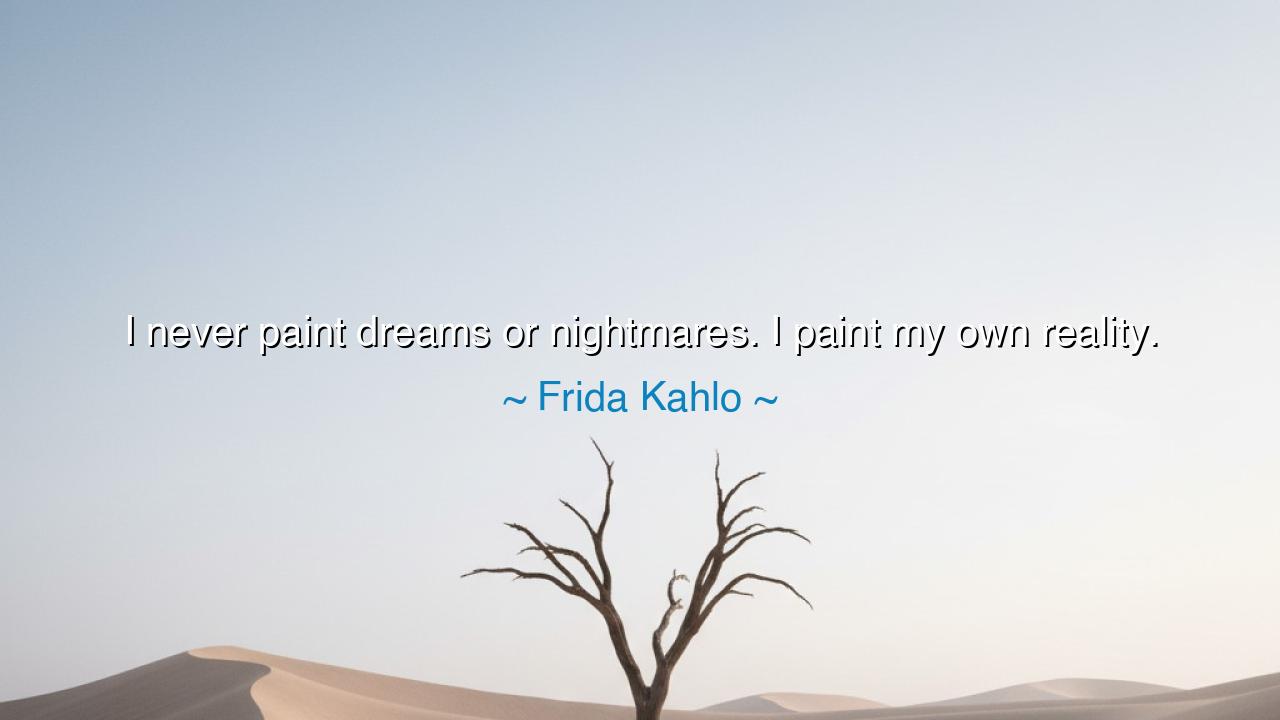
I never paint dreams or nightmares. I paint my own reality.






In this haunting and defiant proclamation, Frida Kahlo declares the sovereignty of her own soul: “I never paint dreams or nightmares. I paint my own reality.” These words are not the whisper of an artist lost in imagination — they are the cry of a warrior who has endured pain, passion, and rebirth. Through them, Kahlo reveals a truth that transcends art: that to create authentically, one must not flee into fantasy, but confront the living fire of one’s own existence. Her art, like her spirit, was not made to escape life, but to transform it. In her hands, suffering became beauty, and truth — however bitter — became liberation.
The origin of this quote lies deep in the labyrinth of Frida’s own life. She was no stranger to agony. From the time of her youth, her body was broken in a terrible bus accident that left her in lifelong pain. Yet it was in that confinement that her imagination took flight. Many would have sought refuge in dreams or illusion, but Frida turned inward and found her own reality — one filled with sorrow, longing, and fierce resilience. Her canvases were not escapist visions; they were mirrors, reflecting every wound, every joy, every contradiction within her being. Through her brush, she said to the world: This is who I am — whole, fractured, eternal.
To paint one’s own reality is an act of tremendous courage. It means to strip away the veils that comfort and deceive. It is far easier to paint the dream — that which is imagined, idealized, or safe — than to paint the truth of what is. Frida understood that the artist’s duty is not to invent beauty, but to reveal it even in the midst of decay. She looked upon her own broken body, her tumultuous love with Diego Rivera, her political turmoil, and her solitude, and turned them into symbols of strength, identity, and defiance. Each stroke of her brush was a confession, each color a fragment of her truth.
Her quote also challenges the false boundary between art and life. Many call Frida a surrealist because of the strangeness and intensity of her imagery, yet she rejected that label. To her, what others called surreal was simply reality as she lived it — raw, emotional, and transcendent. The flowers bursting from wounds, the hearts exposed, the eyes that weep blood — these were not inventions of imagination, but translations of her lived experience. She showed that reality itself can be more astonishing, more mysterious, and more sacred than any dream. For those who have suffered deeply, the line between dream and truth dissolves; what remains is the naked power of being.
There is a lesson here that stretches beyond the realm of art. To face one’s reality — to accept it without disguise — is the beginning of wisdom. Too often, people seek to escape their truth through distraction, denial, or imitation. But in doing so, they lose the power to create, to grow, to live fully. Frida reminds us that even in pain, there is beauty; even in imperfection, there is grace. To live truthfully is to live freely, for no illusion can imprison a soul that dares to say, “This is my life, and I claim it.”
Consider, too, how her philosophy echoes across time. Like Vincent van Gogh, who painted the anguish and glory of his own mind in swirls of light, or Sylvia Plath, who wrote of her inner storms with unflinching honesty, Frida belongs to a lineage of creators who turned their suffering into sacred art. They did not flee from the world — they illuminated it from within. Their courage teaches us that authenticity, though painful, is the purest form of beauty. For truth, once revealed, does not destroy; it heals.
So, my child, let Frida’s words be your guide: do not live in dreams or nightmares spun by others. Do not wait for perfection or peace before creating, speaking, or loving. Look instead upon your own reality — its scars, its laughter, its chaos — and let it become your art, your offering to the world. From the soil of hardship, let your truth bloom like her crimson flowers — wild, imperfect, and eternal.
For as Frida Kahlo reminds us, art — and life itself — begins when we stop pretending. To live as she lived is to say to the world: I am not afraid of my truth, for it is mine. And in that fearless acceptance lies the secret of immortality — the power to turn even pain into poetry, even suffering into light.






AAdministratorAdministrator
Welcome, honored guests. Please leave a comment, we will respond soon